Statistical Analysis: Interpreting Health Research Findings
VerifiedAdded on 2023/06/13
|10
|2582
|162
Report
AI Summary
This report identifies and interprets statistical data in two health-related research articles: one on alcohol and drug use at school leavers' celebrations and the other on the prevalence of diabetes mellitus in a Chinese population. It examines the hypotheses, variables, statistical methods, and study limitations of each article. The analysis includes discussions on sampling methods like stratified random sampling, demographic characteristics of the samples, data analysis techniques such as the Wilcoxon signed rank test and logistic regression, and the interpretation of results and odds ratios. The report also addresses the limitations of each study, such as the representativeness of the sample and the reliance on self-reporting, and their implications on the outcomes. This document is contributed by a student and available on Desklib, where students can find all the necessary AI-based study tools.
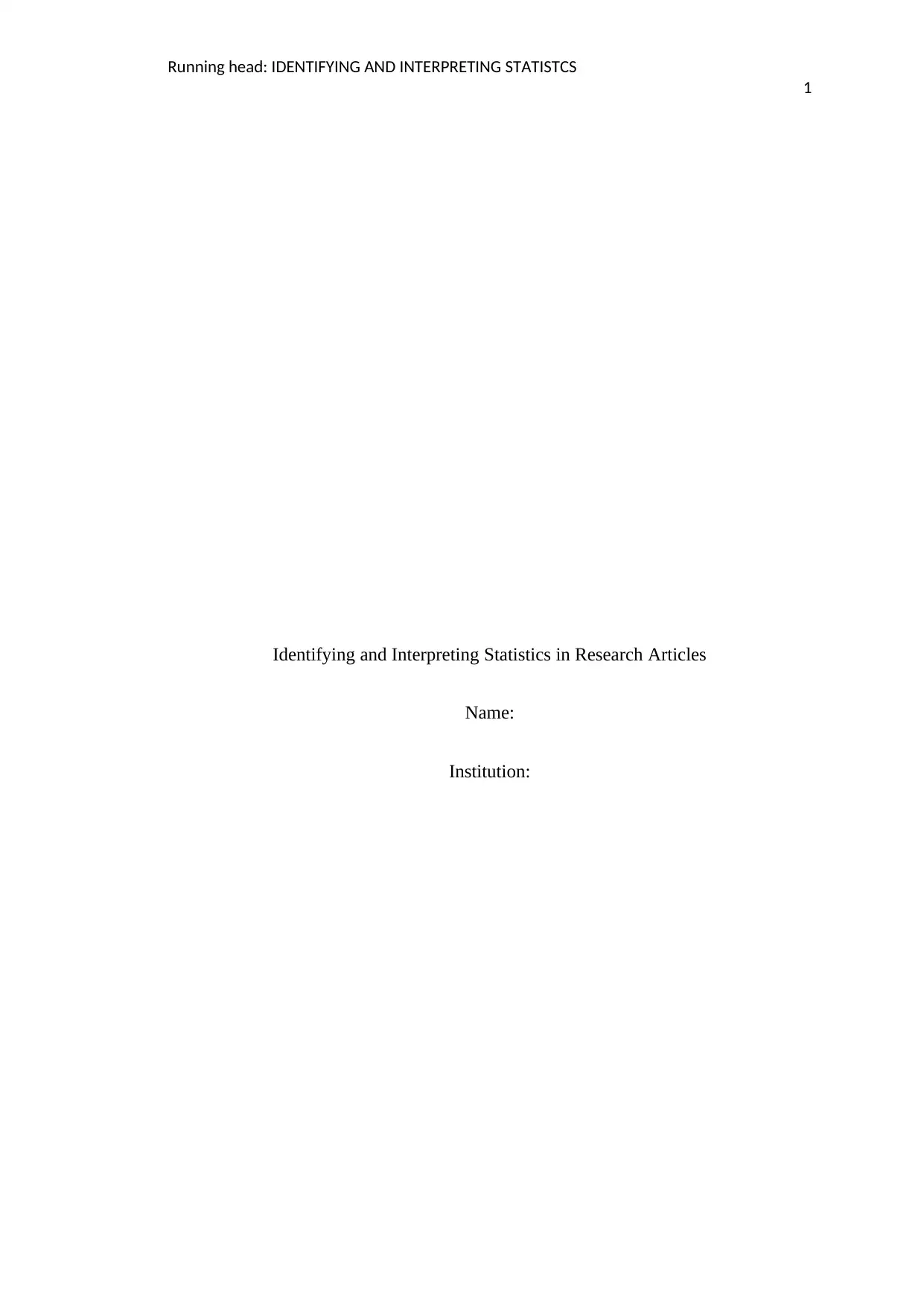
Running head: IDENTIFYING AND INTERPRETING STATISTCS
1
Identifying and Interpreting Statistics in Research Articles
Name:
Institution:
1
Identifying and Interpreting Statistics in Research Articles
Name:
Institution:
Paraphrase This Document
Need a fresh take? Get an instant paraphrase of this document with our AI Paraphraser
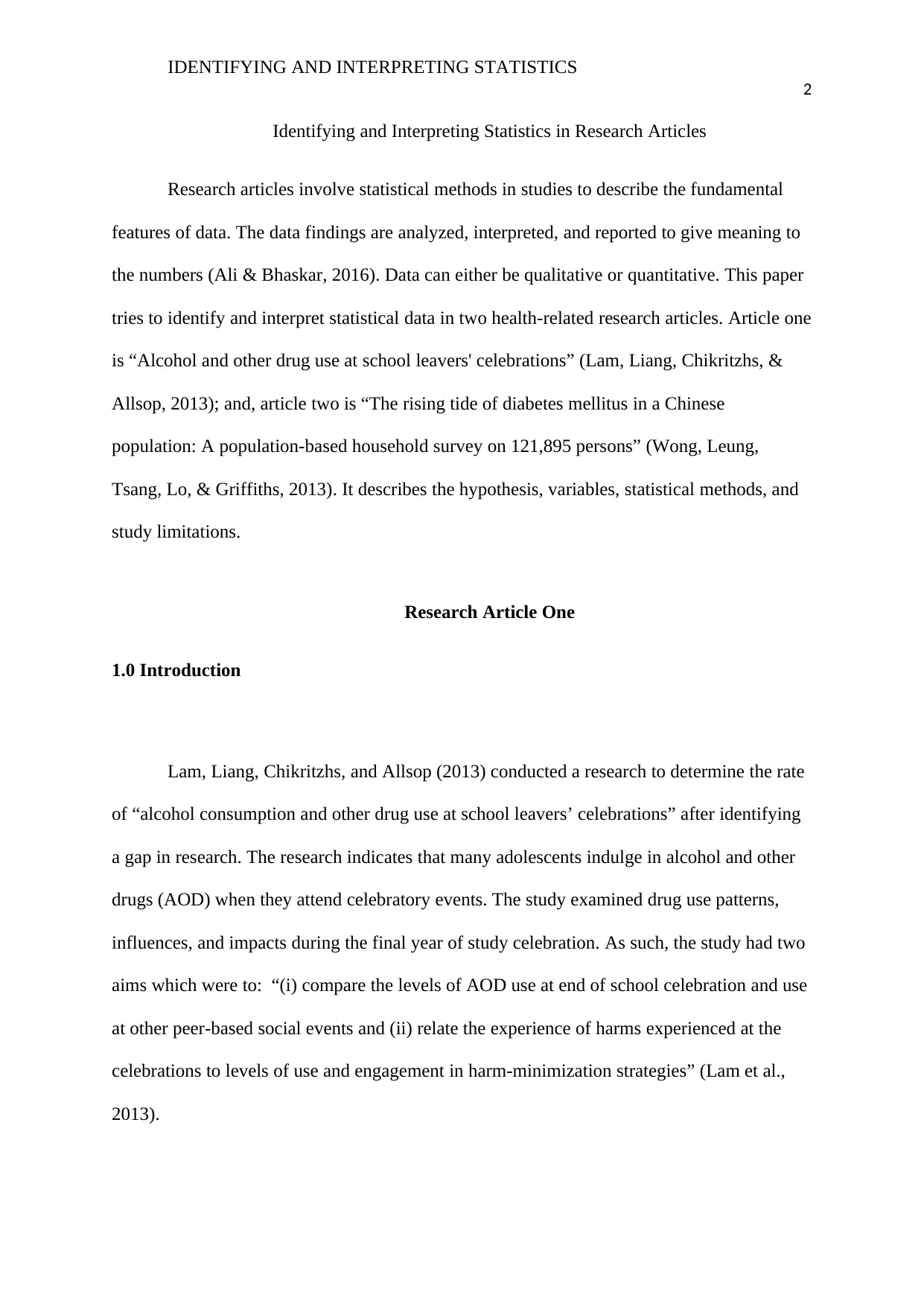
IDENTIFYING AND INTERPRETING STATISTICS
2
Identifying and Interpreting Statistics in Research Articles
Research articles involve statistical methods in studies to describe the fundamental
features of data. The data findings are analyzed, interpreted, and reported to give meaning to
the numbers (Ali & Bhaskar, 2016). Data can either be qualitative or quantitative. This paper
tries to identify and interpret statistical data in two health-related research articles. Article one
is “Alcohol and other drug use at school leavers' celebrations” (Lam, Liang, Chikritzhs, &
Allsop, 2013); and, article two is “The rising tide of diabetes mellitus in a Chinese
population: A population-based household survey on 121,895 persons” (Wong, Leung,
Tsang, Lo, & Griffiths, 2013). It describes the hypothesis, variables, statistical methods, and
study limitations.
Research Article One
1.0 Introduction
Lam, Liang, Chikritzhs, and Allsop (2013) conducted a research to determine the rate
of “alcohol consumption and other drug use at school leavers’ celebrations” after identifying
a gap in research. The research indicates that many adolescents indulge in alcohol and other
drugs (AOD) when they attend celebratory events. The study examined drug use patterns,
influences, and impacts during the final year of study celebration. As such, the study had two
aims which were to: “(i) compare the levels of AOD use at end of school celebration and use
at other peer-based social events and (ii) relate the experience of harms experienced at the
celebrations to levels of use and engagement in harm-minimization strategies” (Lam et al.,
2013).
2
Identifying and Interpreting Statistics in Research Articles
Research articles involve statistical methods in studies to describe the fundamental
features of data. The data findings are analyzed, interpreted, and reported to give meaning to
the numbers (Ali & Bhaskar, 2016). Data can either be qualitative or quantitative. This paper
tries to identify and interpret statistical data in two health-related research articles. Article one
is “Alcohol and other drug use at school leavers' celebrations” (Lam, Liang, Chikritzhs, &
Allsop, 2013); and, article two is “The rising tide of diabetes mellitus in a Chinese
population: A population-based household survey on 121,895 persons” (Wong, Leung,
Tsang, Lo, & Griffiths, 2013). It describes the hypothesis, variables, statistical methods, and
study limitations.
Research Article One
1.0 Introduction
Lam, Liang, Chikritzhs, and Allsop (2013) conducted a research to determine the rate
of “alcohol consumption and other drug use at school leavers’ celebrations” after identifying
a gap in research. The research indicates that many adolescents indulge in alcohol and other
drugs (AOD) when they attend celebratory events. The study examined drug use patterns,
influences, and impacts during the final year of study celebration. As such, the study had two
aims which were to: “(i) compare the levels of AOD use at end of school celebration and use
at other peer-based social events and (ii) relate the experience of harms experienced at the
celebrations to levels of use and engagement in harm-minimization strategies” (Lam et al.,
2013).
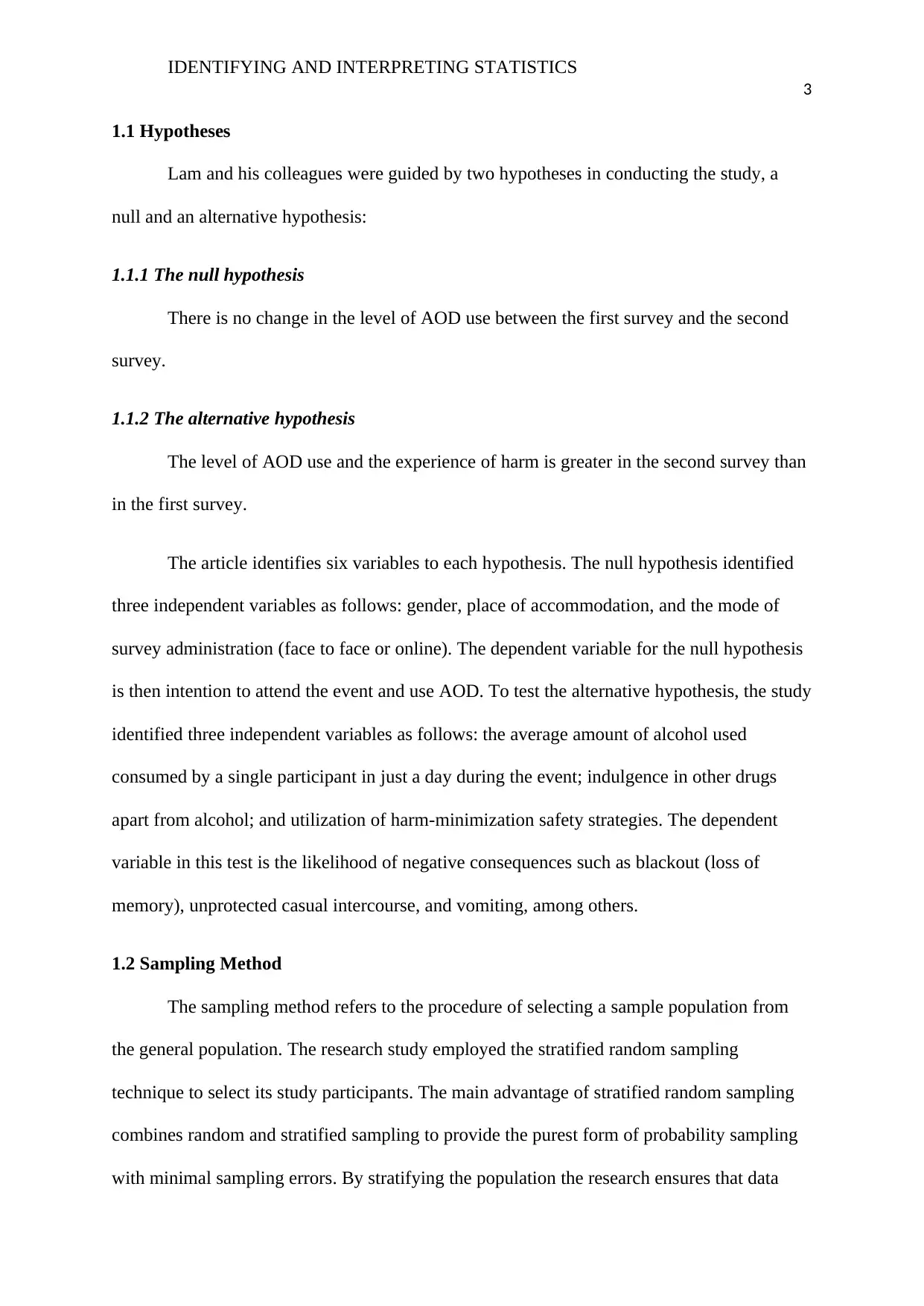
IDENTIFYING AND INTERPRETING STATISTICS
3
1.1 Hypotheses
Lam and his colleagues were guided by two hypotheses in conducting the study, a
null and an alternative hypothesis:
1.1.1 The null hypothesis
There is no change in the level of AOD use between the first survey and the second
survey.
1.1.2 The alternative hypothesis
The level of AOD use and the experience of harm is greater in the second survey than
in the first survey.
The article identifies six variables to each hypothesis. The null hypothesis identified
three independent variables as follows: gender, place of accommodation, and the mode of
survey administration (face to face or online). The dependent variable for the null hypothesis
is then intention to attend the event and use AOD. To test the alternative hypothesis, the study
identified three independent variables as follows: the average amount of alcohol used
consumed by a single participant in just a day during the event; indulgence in other drugs
apart from alcohol; and utilization of harm-minimization safety strategies. The dependent
variable in this test is the likelihood of negative consequences such as blackout (loss of
memory), unprotected casual intercourse, and vomiting, among others.
1.2 Sampling Method
The sampling method refers to the procedure of selecting a sample population from
the general population. The research study employed the stratified random sampling
technique to select its study participants. The main advantage of stratified random sampling
combines random and stratified sampling to provide the purest form of probability sampling
with minimal sampling errors. By stratifying the population the research ensures that data
3
1.1 Hypotheses
Lam and his colleagues were guided by two hypotheses in conducting the study, a
null and an alternative hypothesis:
1.1.1 The null hypothesis
There is no change in the level of AOD use between the first survey and the second
survey.
1.1.2 The alternative hypothesis
The level of AOD use and the experience of harm is greater in the second survey than
in the first survey.
The article identifies six variables to each hypothesis. The null hypothesis identified
three independent variables as follows: gender, place of accommodation, and the mode of
survey administration (face to face or online). The dependent variable for the null hypothesis
is then intention to attend the event and use AOD. To test the alternative hypothesis, the study
identified three independent variables as follows: the average amount of alcohol used
consumed by a single participant in just a day during the event; indulgence in other drugs
apart from alcohol; and utilization of harm-minimization safety strategies. The dependent
variable in this test is the likelihood of negative consequences such as blackout (loss of
memory), unprotected casual intercourse, and vomiting, among others.
1.2 Sampling Method
The sampling method refers to the procedure of selecting a sample population from
the general population. The research study employed the stratified random sampling
technique to select its study participants. The main advantage of stratified random sampling
combines random and stratified sampling to provide the purest form of probability sampling
with minimal sampling errors. By stratifying the population the research ensures that data
⊘ This is a preview!⊘
Do you want full access?
Subscribe today to unlock all pages.

Trusted by 1+ million students worldwide
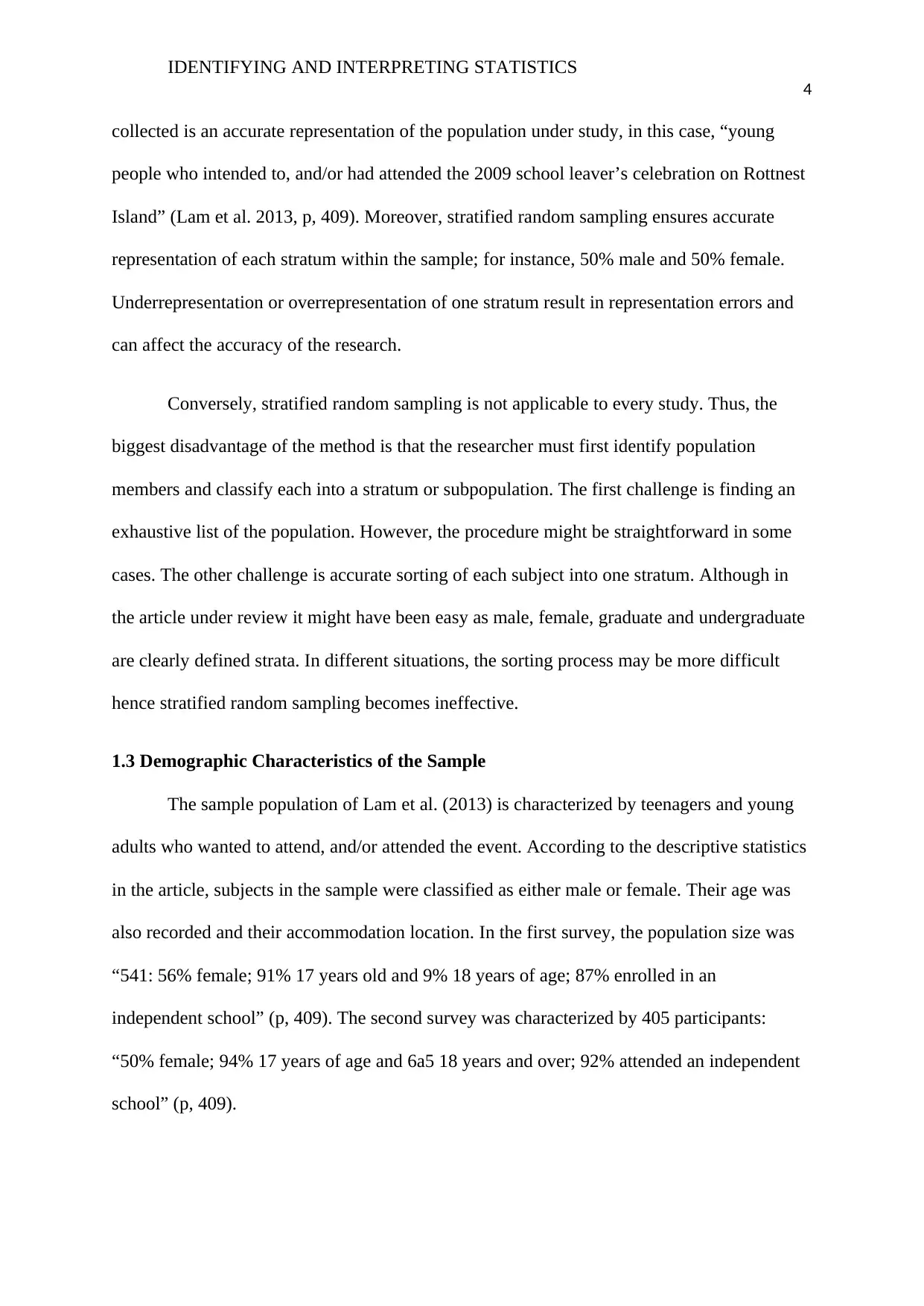
IDENTIFYING AND INTERPRETING STATISTICS
4
collected is an accurate representation of the population under study, in this case, “young
people who intended to, and/or had attended the 2009 school leaver’s celebration on Rottnest
Island” (Lam et al. 2013, p, 409). Moreover, stratified random sampling ensures accurate
representation of each stratum within the sample; for instance, 50% male and 50% female.
Underrepresentation or overrepresentation of one stratum result in representation errors and
can affect the accuracy of the research.
Conversely, stratified random sampling is not applicable to every study. Thus, the
biggest disadvantage of the method is that the researcher must first identify population
members and classify each into a stratum or subpopulation. The first challenge is finding an
exhaustive list of the population. However, the procedure might be straightforward in some
cases. The other challenge is accurate sorting of each subject into one stratum. Although in
the article under review it might have been easy as male, female, graduate and undergraduate
are clearly defined strata. In different situations, the sorting process may be more difficult
hence stratified random sampling becomes ineffective.
1.3 Demographic Characteristics of the Sample
The sample population of Lam et al. (2013) is characterized by teenagers and young
adults who wanted to attend, and/or attended the event. According to the descriptive statistics
in the article, subjects in the sample were classified as either male or female. Their age was
also recorded and their accommodation location. In the first survey, the population size was
“541: 56% female; 91% 17 years old and 9% 18 years of age; 87% enrolled in an
independent school” (p, 409). The second survey was characterized by 405 participants:
“50% female; 94% 17 years of age and 6a5 18 years and over; 92% attended an independent
school” (p, 409).
4
collected is an accurate representation of the population under study, in this case, “young
people who intended to, and/or had attended the 2009 school leaver’s celebration on Rottnest
Island” (Lam et al. 2013, p, 409). Moreover, stratified random sampling ensures accurate
representation of each stratum within the sample; for instance, 50% male and 50% female.
Underrepresentation or overrepresentation of one stratum result in representation errors and
can affect the accuracy of the research.
Conversely, stratified random sampling is not applicable to every study. Thus, the
biggest disadvantage of the method is that the researcher must first identify population
members and classify each into a stratum or subpopulation. The first challenge is finding an
exhaustive list of the population. However, the procedure might be straightforward in some
cases. The other challenge is accurate sorting of each subject into one stratum. Although in
the article under review it might have been easy as male, female, graduate and undergraduate
are clearly defined strata. In different situations, the sorting process may be more difficult
hence stratified random sampling becomes ineffective.
1.3 Demographic Characteristics of the Sample
The sample population of Lam et al. (2013) is characterized by teenagers and young
adults who wanted to attend, and/or attended the event. According to the descriptive statistics
in the article, subjects in the sample were classified as either male or female. Their age was
also recorded and their accommodation location. In the first survey, the population size was
“541: 56% female; 91% 17 years old and 9% 18 years of age; 87% enrolled in an
independent school” (p, 409). The second survey was characterized by 405 participants:
“50% female; 94% 17 years of age and 6a5 18 years and over; 92% attended an independent
school” (p, 409).
Paraphrase This Document
Need a fresh take? Get an instant paraphrase of this document with our AI Paraphraser
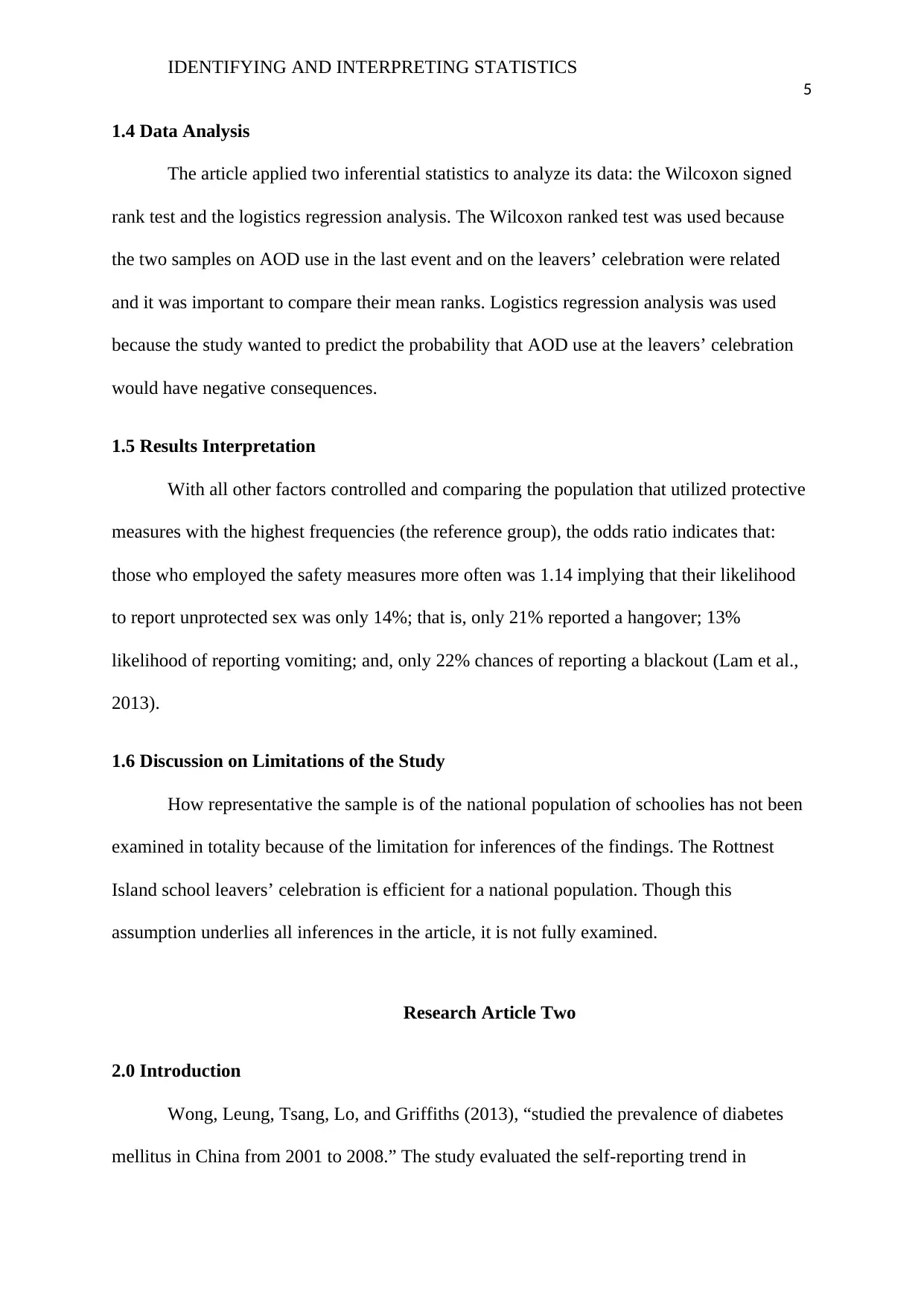
IDENTIFYING AND INTERPRETING STATISTICS
5
1.4 Data Analysis
The article applied two inferential statistics to analyze its data: the Wilcoxon signed
rank test and the logistics regression analysis. The Wilcoxon ranked test was used because
the two samples on AOD use in the last event and on the leavers’ celebration were related
and it was important to compare their mean ranks. Logistics regression analysis was used
because the study wanted to predict the probability that AOD use at the leavers’ celebration
would have negative consequences.
1.5 Results Interpretation
With all other factors controlled and comparing the population that utilized protective
measures with the highest frequencies (the reference group), the odds ratio indicates that:
those who employed the safety measures more often was 1.14 implying that their likelihood
to report unprotected sex was only 14%; that is, only 21% reported a hangover; 13%
likelihood of reporting vomiting; and, only 22% chances of reporting a blackout (Lam et al.,
2013).
1.6 Discussion on Limitations of the Study
How representative the sample is of the national population of schoolies has not been
examined in totality because of the limitation for inferences of the findings. The Rottnest
Island school leavers’ celebration is efficient for a national population. Though this
assumption underlies all inferences in the article, it is not fully examined.
Research Article Two
2.0 Introduction
Wong, Leung, Tsang, Lo, and Griffiths (2013), “studied the prevalence of diabetes
mellitus in China from 2001 to 2008.” The study evaluated the self-reporting trend in
5
1.4 Data Analysis
The article applied two inferential statistics to analyze its data: the Wilcoxon signed
rank test and the logistics regression analysis. The Wilcoxon ranked test was used because
the two samples on AOD use in the last event and on the leavers’ celebration were related
and it was important to compare their mean ranks. Logistics regression analysis was used
because the study wanted to predict the probability that AOD use at the leavers’ celebration
would have negative consequences.
1.5 Results Interpretation
With all other factors controlled and comparing the population that utilized protective
measures with the highest frequencies (the reference group), the odds ratio indicates that:
those who employed the safety measures more often was 1.14 implying that their likelihood
to report unprotected sex was only 14%; that is, only 21% reported a hangover; 13%
likelihood of reporting vomiting; and, only 22% chances of reporting a blackout (Lam et al.,
2013).
1.6 Discussion on Limitations of the Study
How representative the sample is of the national population of schoolies has not been
examined in totality because of the limitation for inferences of the findings. The Rottnest
Island school leavers’ celebration is efficient for a national population. Though this
assumption underlies all inferences in the article, it is not fully examined.
Research Article Two
2.0 Introduction
Wong, Leung, Tsang, Lo, and Griffiths (2013), “studied the prevalence of diabetes
mellitus in China from 2001 to 2008.” The study evaluated the self-reporting trend in
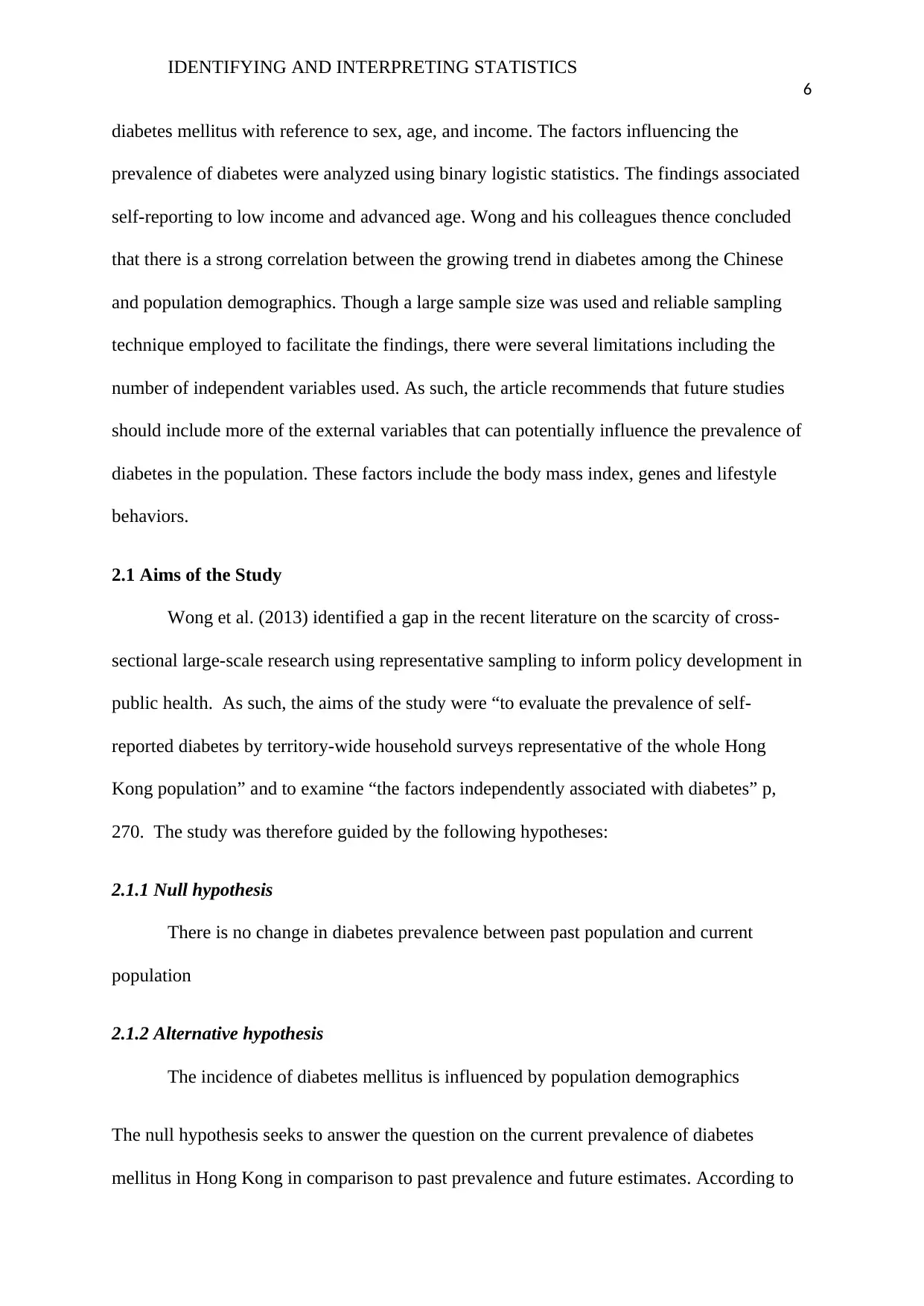
IDENTIFYING AND INTERPRETING STATISTICS
6
diabetes mellitus with reference to sex, age, and income. The factors influencing the
prevalence of diabetes were analyzed using binary logistic statistics. The findings associated
self-reporting to low income and advanced age. Wong and his colleagues thence concluded
that there is a strong correlation between the growing trend in diabetes among the Chinese
and population demographics. Though a large sample size was used and reliable sampling
technique employed to facilitate the findings, there were several limitations including the
number of independent variables used. As such, the article recommends that future studies
should include more of the external variables that can potentially influence the prevalence of
diabetes in the population. These factors include the body mass index, genes and lifestyle
behaviors.
2.1 Aims of the Study
Wong et al. (2013) identified a gap in the recent literature on the scarcity of cross-
sectional large-scale research using representative sampling to inform policy development in
public health. As such, the aims of the study were “to evaluate the prevalence of self-
reported diabetes by territory-wide household surveys representative of the whole Hong
Kong population” and to examine “the factors independently associated with diabetes” p,
270. The study was therefore guided by the following hypotheses:
2.1.1 Null hypothesis
There is no change in diabetes prevalence between past population and current
population
2.1.2 Alternative hypothesis
The incidence of diabetes mellitus is influenced by population demographics
The null hypothesis seeks to answer the question on the current prevalence of diabetes
mellitus in Hong Kong in comparison to past prevalence and future estimates. According to
6
diabetes mellitus with reference to sex, age, and income. The factors influencing the
prevalence of diabetes were analyzed using binary logistic statistics. The findings associated
self-reporting to low income and advanced age. Wong and his colleagues thence concluded
that there is a strong correlation between the growing trend in diabetes among the Chinese
and population demographics. Though a large sample size was used and reliable sampling
technique employed to facilitate the findings, there were several limitations including the
number of independent variables used. As such, the article recommends that future studies
should include more of the external variables that can potentially influence the prevalence of
diabetes in the population. These factors include the body mass index, genes and lifestyle
behaviors.
2.1 Aims of the Study
Wong et al. (2013) identified a gap in the recent literature on the scarcity of cross-
sectional large-scale research using representative sampling to inform policy development in
public health. As such, the aims of the study were “to evaluate the prevalence of self-
reported diabetes by territory-wide household surveys representative of the whole Hong
Kong population” and to examine “the factors independently associated with diabetes” p,
270. The study was therefore guided by the following hypotheses:
2.1.1 Null hypothesis
There is no change in diabetes prevalence between past population and current
population
2.1.2 Alternative hypothesis
The incidence of diabetes mellitus is influenced by population demographics
The null hypothesis seeks to answer the question on the current prevalence of diabetes
mellitus in Hong Kong in comparison to past prevalence and future estimates. According to
⊘ This is a preview!⊘
Do you want full access?
Subscribe today to unlock all pages.

Trusted by 1+ million students worldwide
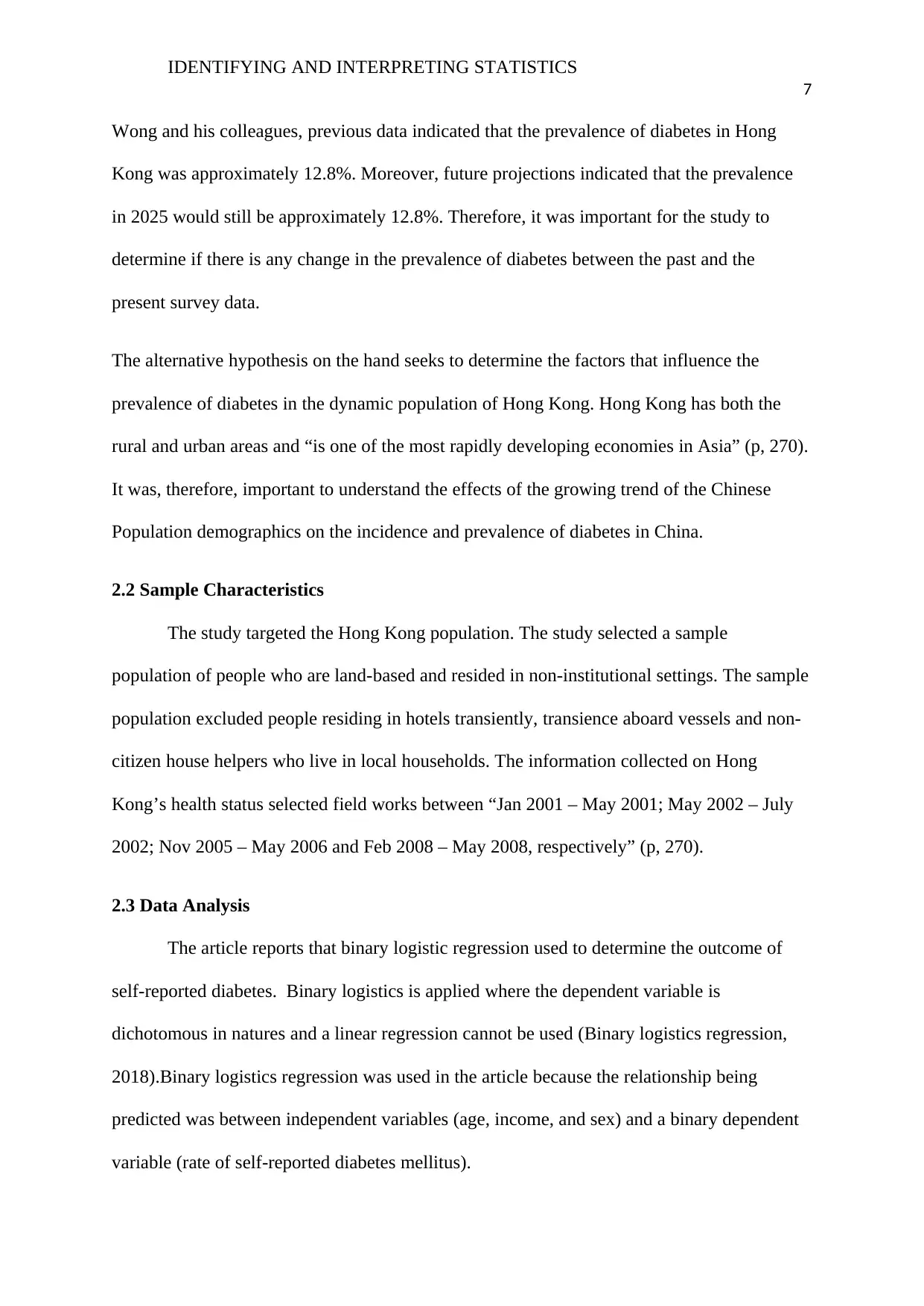
IDENTIFYING AND INTERPRETING STATISTICS
7
Wong and his colleagues, previous data indicated that the prevalence of diabetes in Hong
Kong was approximately 12.8%. Moreover, future projections indicated that the prevalence
in 2025 would still be approximately 12.8%. Therefore, it was important for the study to
determine if there is any change in the prevalence of diabetes between the past and the
present survey data.
The alternative hypothesis on the hand seeks to determine the factors that influence the
prevalence of diabetes in the dynamic population of Hong Kong. Hong Kong has both the
rural and urban areas and “is one of the most rapidly developing economies in Asia” (p, 270).
It was, therefore, important to understand the effects of the growing trend of the Chinese
Population demographics on the incidence and prevalence of diabetes in China.
2.2 Sample Characteristics
The study targeted the Hong Kong population. The study selected a sample
population of people who are land-based and resided in non-institutional settings. The sample
population excluded people residing in hotels transiently, transience aboard vessels and non-
citizen house helpers who live in local households. The information collected on Hong
Kong’s health status selected field works between “Jan 2001 – May 2001; May 2002 – July
2002; Nov 2005 – May 2006 and Feb 2008 – May 2008, respectively” (p, 270).
2.3 Data Analysis
The article reports that binary logistic regression used to determine the outcome of
self-reported diabetes. Binary logistics is applied where the dependent variable is
dichotomous in natures and a linear regression cannot be used (Binary logistics regression,
2018).Binary logistics regression was used in the article because the relationship being
predicted was between independent variables (age, income, and sex) and a binary dependent
variable (rate of self-reported diabetes mellitus).
7
Wong and his colleagues, previous data indicated that the prevalence of diabetes in Hong
Kong was approximately 12.8%. Moreover, future projections indicated that the prevalence
in 2025 would still be approximately 12.8%. Therefore, it was important for the study to
determine if there is any change in the prevalence of diabetes between the past and the
present survey data.
The alternative hypothesis on the hand seeks to determine the factors that influence the
prevalence of diabetes in the dynamic population of Hong Kong. Hong Kong has both the
rural and urban areas and “is one of the most rapidly developing economies in Asia” (p, 270).
It was, therefore, important to understand the effects of the growing trend of the Chinese
Population demographics on the incidence and prevalence of diabetes in China.
2.2 Sample Characteristics
The study targeted the Hong Kong population. The study selected a sample
population of people who are land-based and resided in non-institutional settings. The sample
population excluded people residing in hotels transiently, transience aboard vessels and non-
citizen house helpers who live in local households. The information collected on Hong
Kong’s health status selected field works between “Jan 2001 – May 2001; May 2002 – July
2002; Nov 2005 – May 2006 and Feb 2008 – May 2008, respectively” (p, 270).
2.3 Data Analysis
The article reports that binary logistic regression used to determine the outcome of
self-reported diabetes. Binary logistics is applied where the dependent variable is
dichotomous in natures and a linear regression cannot be used (Binary logistics regression,
2018).Binary logistics regression was used in the article because the relationship being
predicted was between independent variables (age, income, and sex) and a binary dependent
variable (rate of self-reported diabetes mellitus).
Paraphrase This Document
Need a fresh take? Get an instant paraphrase of this document with our AI Paraphraser
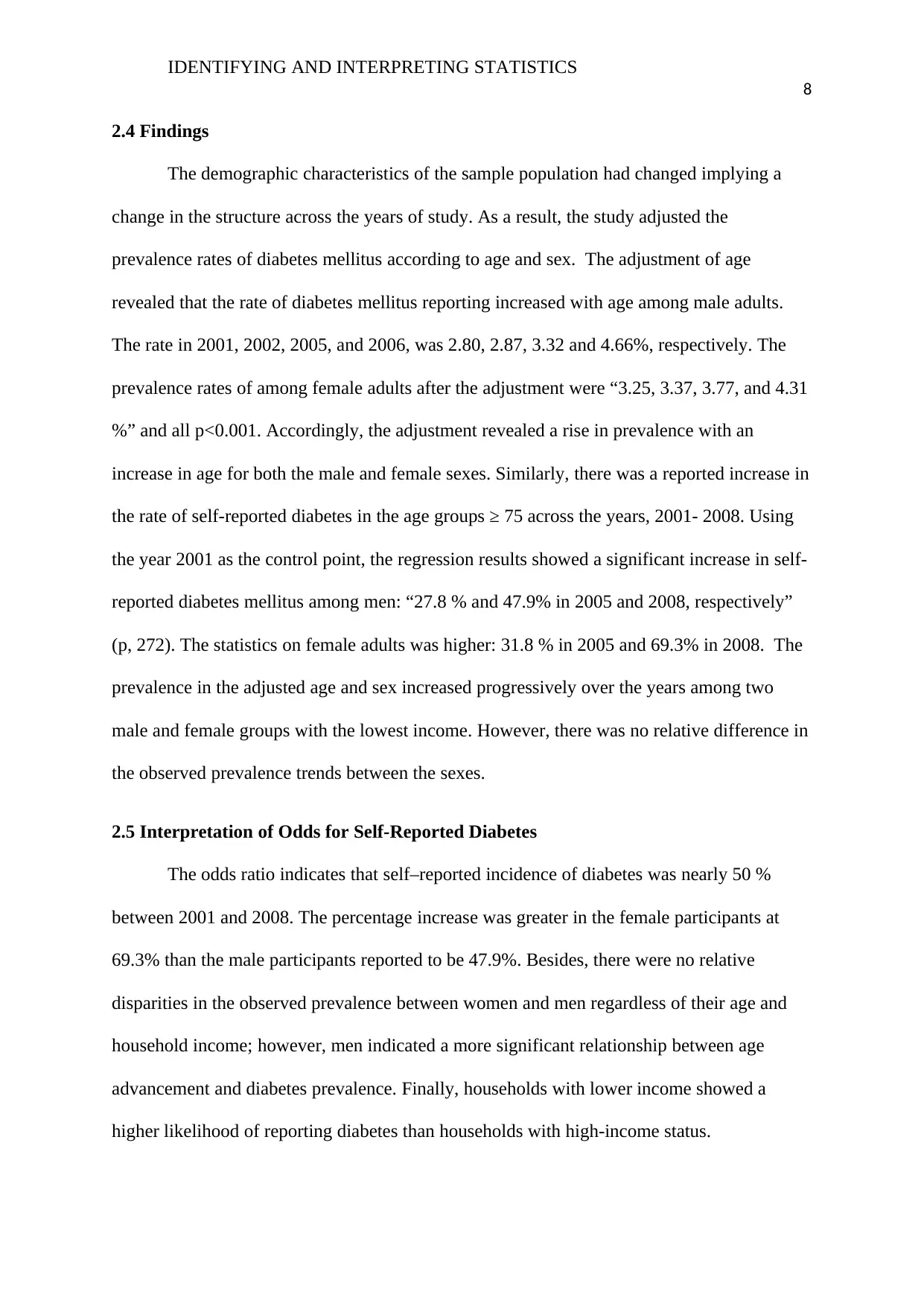
IDENTIFYING AND INTERPRETING STATISTICS
8
2.4 Findings
The demographic characteristics of the sample population had changed implying a
change in the structure across the years of study. As a result, the study adjusted the
prevalence rates of diabetes mellitus according to age and sex. The adjustment of age
revealed that the rate of diabetes mellitus reporting increased with age among male adults.
The rate in 2001, 2002, 2005, and 2006, was 2.80, 2.87, 3.32 and 4.66%, respectively. The
prevalence rates of among female adults after the adjustment were “3.25, 3.37, 3.77, and 4.31
%” and all p<0.001. Accordingly, the adjustment revealed a rise in prevalence with an
increase in age for both the male and female sexes. Similarly, there was a reported increase in
the rate of self-reported diabetes in the age groups ≥ 75 across the years, 2001- 2008. Using
the year 2001 as the control point, the regression results showed a significant increase in self-
reported diabetes mellitus among men: “27.8 % and 47.9% in 2005 and 2008, respectively”
(p, 272). The statistics on female adults was higher: 31.8 % in 2005 and 69.3% in 2008. The
prevalence in the adjusted age and sex increased progressively over the years among two
male and female groups with the lowest income. However, there was no relative difference in
the observed prevalence trends between the sexes.
2.5 Interpretation of Odds for Self-Reported Diabetes
The odds ratio indicates that self–reported incidence of diabetes was nearly 50 %
between 2001 and 2008. The percentage increase was greater in the female participants at
69.3% than the male participants reported to be 47.9%. Besides, there were no relative
disparities in the observed prevalence between women and men regardless of their age and
household income; however, men indicated a more significant relationship between age
advancement and diabetes prevalence. Finally, households with lower income showed a
higher likelihood of reporting diabetes than households with high-income status.
8
2.4 Findings
The demographic characteristics of the sample population had changed implying a
change in the structure across the years of study. As a result, the study adjusted the
prevalence rates of diabetes mellitus according to age and sex. The adjustment of age
revealed that the rate of diabetes mellitus reporting increased with age among male adults.
The rate in 2001, 2002, 2005, and 2006, was 2.80, 2.87, 3.32 and 4.66%, respectively. The
prevalence rates of among female adults after the adjustment were “3.25, 3.37, 3.77, and 4.31
%” and all p<0.001. Accordingly, the adjustment revealed a rise in prevalence with an
increase in age for both the male and female sexes. Similarly, there was a reported increase in
the rate of self-reported diabetes in the age groups ≥ 75 across the years, 2001- 2008. Using
the year 2001 as the control point, the regression results showed a significant increase in self-
reported diabetes mellitus among men: “27.8 % and 47.9% in 2005 and 2008, respectively”
(p, 272). The statistics on female adults was higher: 31.8 % in 2005 and 69.3% in 2008. The
prevalence in the adjusted age and sex increased progressively over the years among two
male and female groups with the lowest income. However, there was no relative difference in
the observed prevalence trends between the sexes.
2.5 Interpretation of Odds for Self-Reported Diabetes
The odds ratio indicates that self–reported incidence of diabetes was nearly 50 %
between 2001 and 2008. The percentage increase was greater in the female participants at
69.3% than the male participants reported to be 47.9%. Besides, there were no relative
disparities in the observed prevalence between women and men regardless of their age and
household income; however, men indicated a more significant relationship between age
advancement and diabetes prevalence. Finally, households with lower income showed a
higher likelihood of reporting diabetes than households with high-income status.
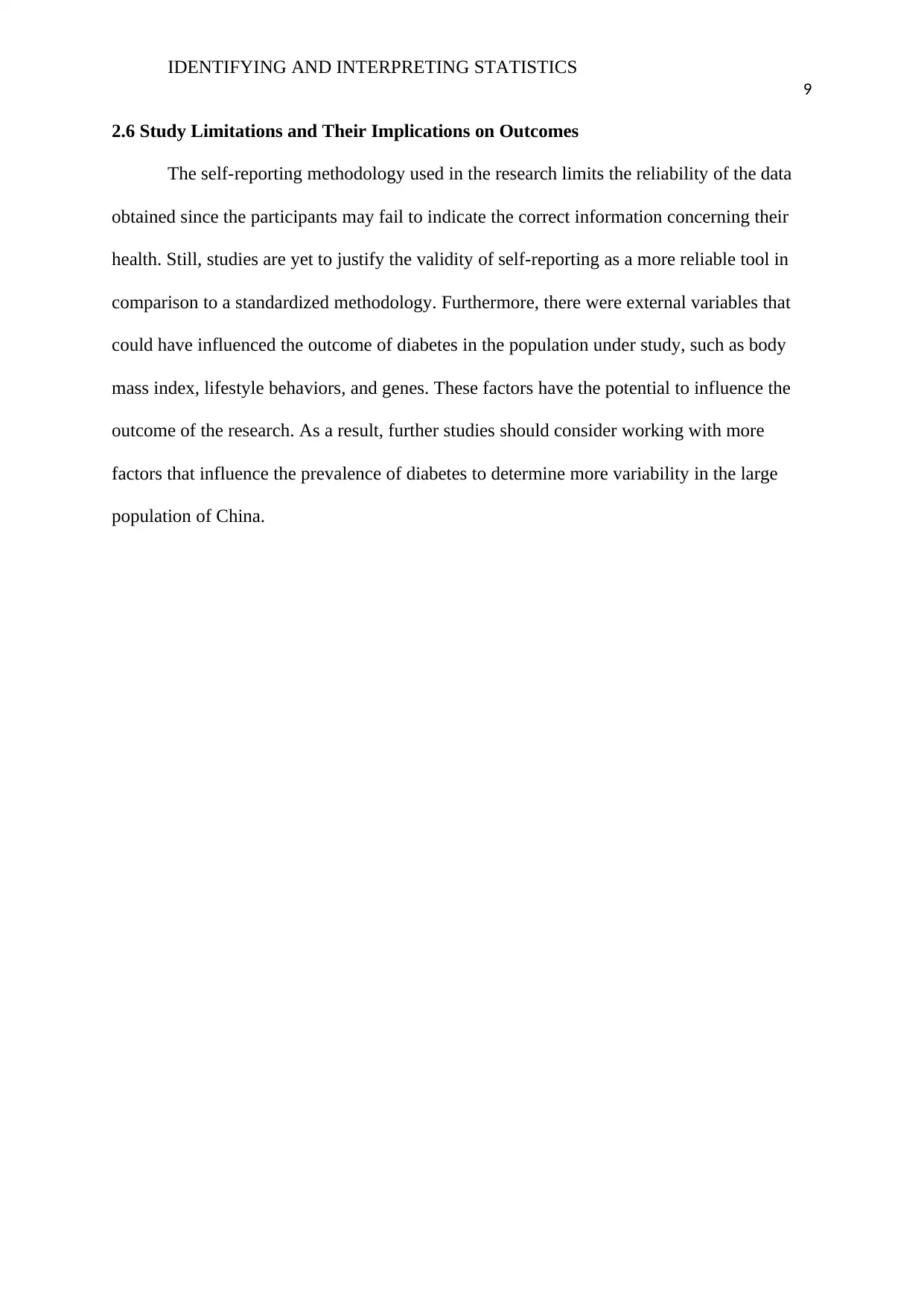
IDENTIFYING AND INTERPRETING STATISTICS
9
2.6 Study Limitations and Their Implications on Outcomes
The self-reporting methodology used in the research limits the reliability of the data
obtained since the participants may fail to indicate the correct information concerning their
health. Still, studies are yet to justify the validity of self-reporting as a more reliable tool in
comparison to a standardized methodology. Furthermore, there were external variables that
could have influenced the outcome of diabetes in the population under study, such as body
mass index, lifestyle behaviors, and genes. These factors have the potential to influence the
outcome of the research. As a result, further studies should consider working with more
factors that influence the prevalence of diabetes to determine more variability in the large
population of China.
9
2.6 Study Limitations and Their Implications on Outcomes
The self-reporting methodology used in the research limits the reliability of the data
obtained since the participants may fail to indicate the correct information concerning their
health. Still, studies are yet to justify the validity of self-reporting as a more reliable tool in
comparison to a standardized methodology. Furthermore, there were external variables that
could have influenced the outcome of diabetes in the population under study, such as body
mass index, lifestyle behaviors, and genes. These factors have the potential to influence the
outcome of the research. As a result, further studies should consider working with more
factors that influence the prevalence of diabetes to determine more variability in the large
population of China.
⊘ This is a preview!⊘
Do you want full access?
Subscribe today to unlock all pages.

Trusted by 1+ million students worldwide
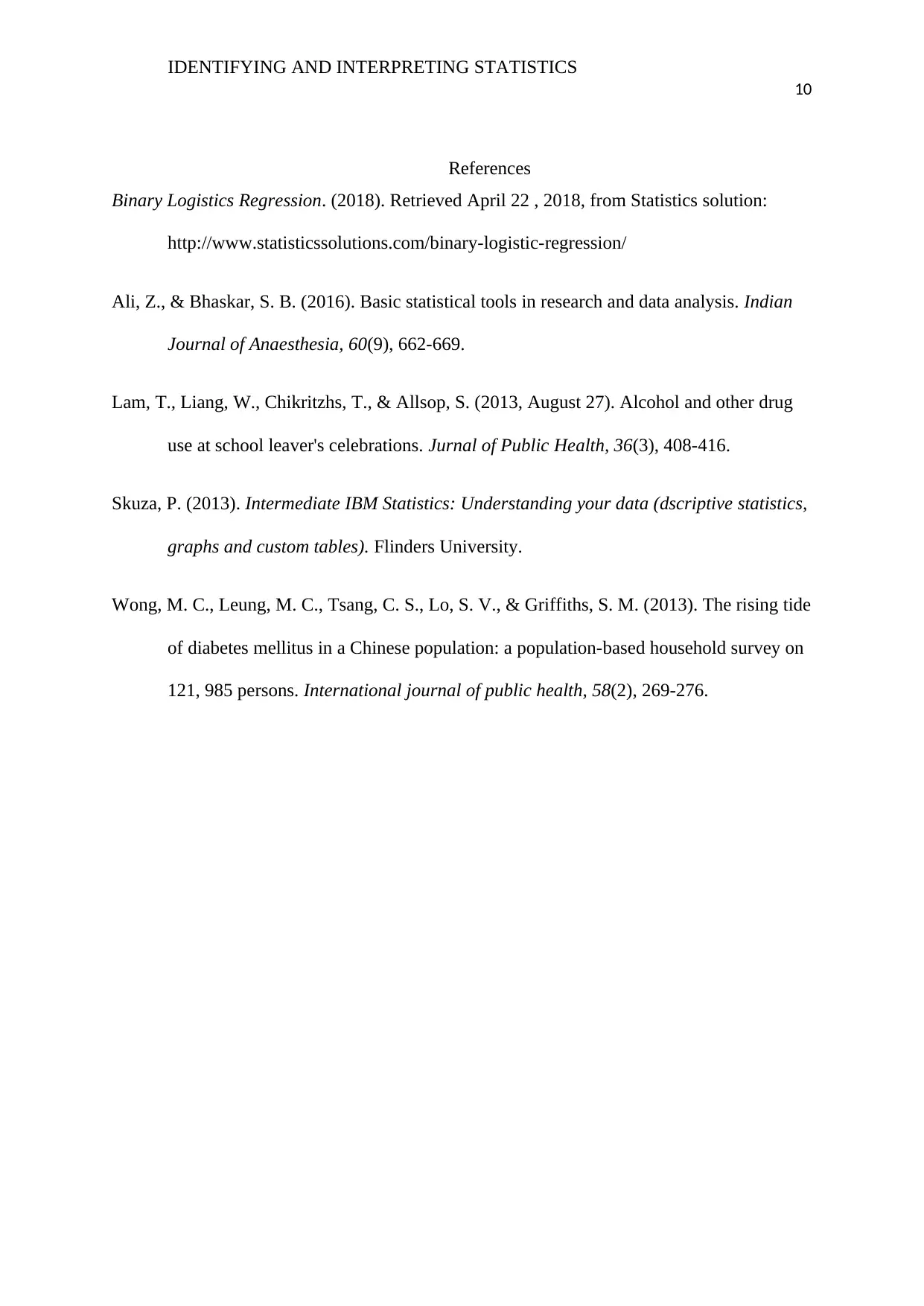
IDENTIFYING AND INTERPRETING STATISTICS
10
References
Binary Logistics Regression. (2018). Retrieved April 22 , 2018, from Statistics solution:
http://www.statisticssolutions.com/binary-logistic-regression/
Ali, Z., & Bhaskar, S. B. (2016). Basic statistical tools in research and data analysis. Indian
Journal of Anaesthesia, 60(9), 662-669.
Lam, T., Liang, W., Chikritzhs, T., & Allsop, S. (2013, August 27). Alcohol and other drug
use at school leaver's celebrations. Jurnal of Public Health, 36(3), 408-416.
Skuza, P. (2013). Intermediate IBM Statistics: Understanding your data (dscriptive statistics,
graphs and custom tables). Flinders University.
Wong, M. C., Leung, M. C., Tsang, C. S., Lo, S. V., & Griffiths, S. M. (2013). The rising tide
of diabetes mellitus in a Chinese population: a population-based household survey on
121, 985 persons. International journal of public health, 58(2), 269-276.
10
References
Binary Logistics Regression. (2018). Retrieved April 22 , 2018, from Statistics solution:
http://www.statisticssolutions.com/binary-logistic-regression/
Ali, Z., & Bhaskar, S. B. (2016). Basic statistical tools in research and data analysis. Indian
Journal of Anaesthesia, 60(9), 662-669.
Lam, T., Liang, W., Chikritzhs, T., & Allsop, S. (2013, August 27). Alcohol and other drug
use at school leaver's celebrations. Jurnal of Public Health, 36(3), 408-416.
Skuza, P. (2013). Intermediate IBM Statistics: Understanding your data (dscriptive statistics,
graphs and custom tables). Flinders University.
Wong, M. C., Leung, M. C., Tsang, C. S., Lo, S. V., & Griffiths, S. M. (2013). The rising tide
of diabetes mellitus in a Chinese population: a population-based household survey on
121, 985 persons. International journal of public health, 58(2), 269-276.
1 out of 10
Related Documents
Your All-in-One AI-Powered Toolkit for Academic Success.
+13062052269
info@desklib.com
Available 24*7 on WhatsApp / Email
![[object Object]](/_next/static/media/star-bottom.7253800d.svg)
Unlock your academic potential
Copyright © 2020–2025 A2Z Services. All Rights Reserved. Developed and managed by ZUCOL.





